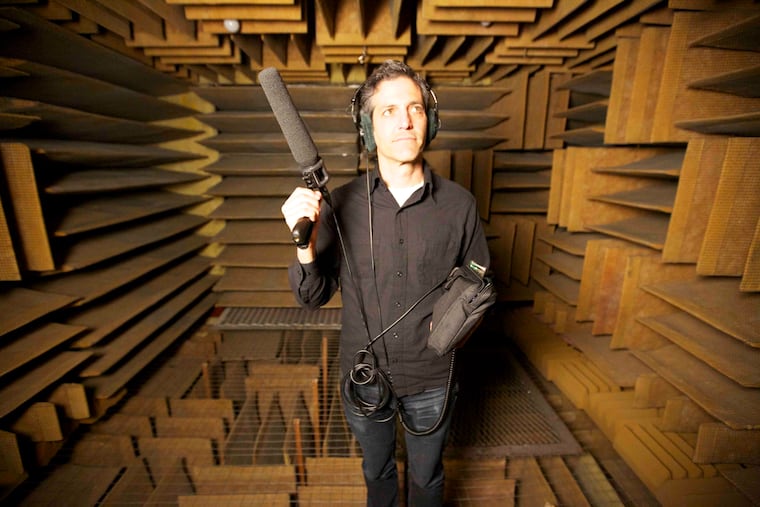Noise-canceling headphones, impromptu dancing, and in-person narration: Experience a ‘live’ documentary at U Arts
Oscar-nominated documentarian Sam Green's "32 Sounds" is playing at Philly's University of the Arts on Saturday. The film is an immersive experience that explores the cosmos of sound around us.

There’s a heady idea in film theory, popularly articulated by Alfred Hitchcock, called “pure cinema.” At its most basic level, pure cinema states that a film creates meaning purely through the arrangement of images.
A classic example is Psycho’s shower scene. Through camera arrangement and the careful stitching together of discrete images — Janet Leigh’s screaming mouth, a shadowy figure, a hand gripping a shower curtain, blood spiraling down a drain, a wide-open eye — Hitchcock develops suspense and suggests a level of grisly violence that is not actually depicted. No words. No exposition. “Pure” cinema.
To Oscar-nominated documentarian Sam Green, the idea of pure cinema substantially lacks one thing: sound. “We’re such visual people,” says Green, “Visual things are easy to understand. They’re right in front of you. Sound is this mysterious force that we can’t see. It works on us at a distance, and it connects us in odd ways.”
Green’s Sundance-premiering latest work, 32 Sounds, which plays on Saturday, Oct. 15, at Philly’s University of the Arts, grapples with the mystery of sound. It also deepens that mystery, inviting us to consider how the soundscape of everyday life shapes our conception of the world.
32 Sounds grew out of a previous project, A Thousand Thoughts, which documented the work of the Kronos Quartet, the San Francisco-based chamber ensemble.
“With the Kronos film, I really wanted people to open their ears,” Green explains. “If you open your ears and listen to Kronos, it’s an amazing experience. But if you just listen to it as background music, it’s not.”
Green was curious about how to make audiences listen more intently. So as to, as he puts it, “scramble their natural posture.” 32 Sounds follows that curiosity. The film investigates sound as both an experience and a concept, through an exploration of discrete sounds: from the sound of the womb, to falling snow, to Ella Fitzgerald’s high-pitched singing shattering a wine glass in an old ad for Memorex-brand magnetic tapes.
Even beyond its subject matter, 32 Sounds is unconventional. In its own “pure” form, it is a “live” documentary. Not screened, but performed live.
Audiences are fitted with noise-canceling headphones and the film’s soundtrack is mixed live, while Green narrates in-person. It is participatory — the audience is asked to close their eyes and imagine certain things. During a mid-film interlude, Green even implores guests to get up and dance.
“If you give yourself to it a little bit,” Green says, “you will leave the theater with open ears, and you will hear the world differently than you have before.”
Amid its assemblage of vignettes (Green was inspired by François Girard’s 1993 anthology documentary Thirty Two Short Films About Glenn Gould), 32 Sounds showcases one character who serves as the documentary’s ostensible human protagonist. Annea Lockwood, 83, is a New Zealand-born American avant-garde composer with a long career of investigating sound.
In the late ‘60s, Lockwood staged concerts where she’d smash glass in total darkness. In another famous piece, she set fire to an upright piano. “I wanted to record [the sound of] a fire,” she says, speaking from Cologne, Germany. “It all came out of my love for really weird juxtapositions.”
Early this year, she collaborated with artist Liz Phillips to create a sound installation called The River Feeds Back, a sonic soundscape of the Schuylkill.
In 32 Sounds, Lockwood is shown recording rivers and marshes, capturing the aural life of an environment. “If I’m listening to something, I’m aware of it being separate from me,” she explains. “I came up with listening with to suggest undermining that sense of separation.”
If Hitchcock was after “pure cinema,” then Lockwood’s pursuit is of something like “pure sound” — documenting what she calls the “soundworld.”
Her ideas push and clarify Green’s own exploration. As it reveals its own rich, varied, playful soundworld, 32 Sounds invites viewers (and listeners) to consider their role within a larger sonic cosmos of glass shattering, rivers murmuring, and hearts beating.
Green hopes audiences will think of sound as more than “the thing in the background that makes people feel stuff.”
In cinema, as in life, sound is no mere supplement to the image. After all, what is Psycho’s shower scene without the screeching strings on the soundtrack or Janet Leigh’s iconic scream?
Sam Green’s 32 Sounds plays at Lightbox Film Center, 401 S Broad St, Phila., Oct 15., 7 p.m.
Annea Lockwood and Liz Phillips’ The River Feeds Back is playing at The Academy of Natural Sciences of Drexel University, 1900 Benjamin Franklin Parkway, Phila. until Oct. 30.